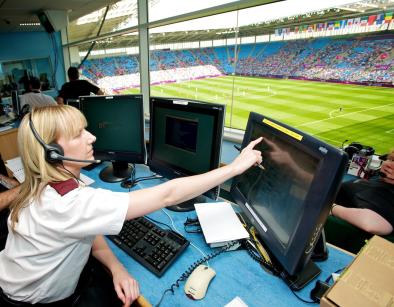

How to Ensure Security at Large Events
Ensuring security is essential when holding large events, due to the large number of people who tend to congregate at them. Organisers have to provide evacuation routes, ensure the stability of the building, limit the presence of hazardous materials, ensure that technical equipment is in good working order and provide emergency fire-fighting equipment, as well as providing appropriate training and instructing for staff. The Director of the School of Prevention and Integral Safety and Security at the UAB, the President of the Spanish Association of Security Companies (AES), and the President of Tecnifuego explain how to act now to avoid lamenting casualties later on. Read more
Whether it’s a sporting event, concert or other mass gathering, large events require special attention to security and emergency management. Montserrat Iglesias, Director of the School of Prevention and Integral Safety and Security of the Autonomous University of Barcelona said that there are three essential phases in ensuring security and prevention at this type of event. The first is planning: “we need to evaluate which risk factors might occur during the event and design the necessary security actions to prevent them.”
The second is intervention. “This involves executing the security plan drawn up beforehand. This second phase is dynamic: the technicians involved continue analysing the event to adapt the measures as necessary.” And the third phase is evaluation: “it’s very important to reflect on and analyse the management carried out in order to improve the effectiveness of future interventions.”
Main Measures
Paloma Velasco, Executive Director of the Spanish Association of Security Companies (AES), warned that at large events it is essential to ensure that the necessary security measures are in place. These are enumerated by the Council of the European Union as follows: “safe escape routes are available, are clearly indicated and remain accessible and unobstructed; the building’s structural stability is guaranteed at least for as long as is needed for the occupants to evacuate the building safely; the presence or use of highly flammable materials is carefully limited; all technical equipment and appliances operate safely; escape routes are displayed; equipment is provided and maintained in proper working order; safety instructions and a plan of the premises with an indication of the escape routes are displayed in each room normally occupied; emergency equipment in proper working order; and that the staff is given suitable instruction and training.”
AES believes that security should be a matter not of cost but of principle. “It is necessary to work on awareness and conviction about the real implementation of a business culture of prevention and safety. And a firm commitment from all levels of government, which are those that must ensure that all the safety measures included in the self-protection plan are complied with at all times.”
Fires: the Most Common Risks
Adrián Gómez, president of Tecnifuego (Spanish Association of Fire Protection Companies), pointed out that fires are one of the most common risks in leisure spaces and large events when thousands of people gather in a building, football field, or concert hall. “In most cases, it doesn’t get out of hand —it can be extinguished with the available equipment and the cost is easily borne by the insurance company— in others there can be serious consequences, including death, and that keeps management concerned about correct execution of fire protection design, installation and maintenance.”
The best form of protection is always one designed by a company specialized in fire protection. In Spain, leisure venues are obliged to implement a series of safety measures required by the Technical Building Code (CTE-DB SI, Technical Building Code), each Autonomous Region’s regulations and, in many cases, municipal ordinances. “An important aspect is proper compartmentation and evacuation provisions, and in premises over 10,000 m2 the installation of detection systems, automatic sprinklers and smoke evacuation systems and, of course, fire extinguishers, fully equipped fire hoses, fire doors, external hydrant for use by firefighters, etc.”
For their part, companies that carry out installation and maintenance work “must meet the requirements of the Fire Protection Installations Regulations (RIPCI), such as having a quality management system certificate; projects must comply with the requirements of the UNE 157001 standard; regulatory inspections; liability insurance, etc.”
On the other hand, fire safety is a set of actions and equipment, which requires specialization in design, installation and maintenance. “We want to emphasize this last aspect, which is sometimes neglected, as these installations are only used when a fire breaks out and so the maintenance plan must be scrupulously followed to ensure they are in good working order. Fires kill, but with adequate prevention measures and proper maintenance, protection is possible even at events with large crowds.”





